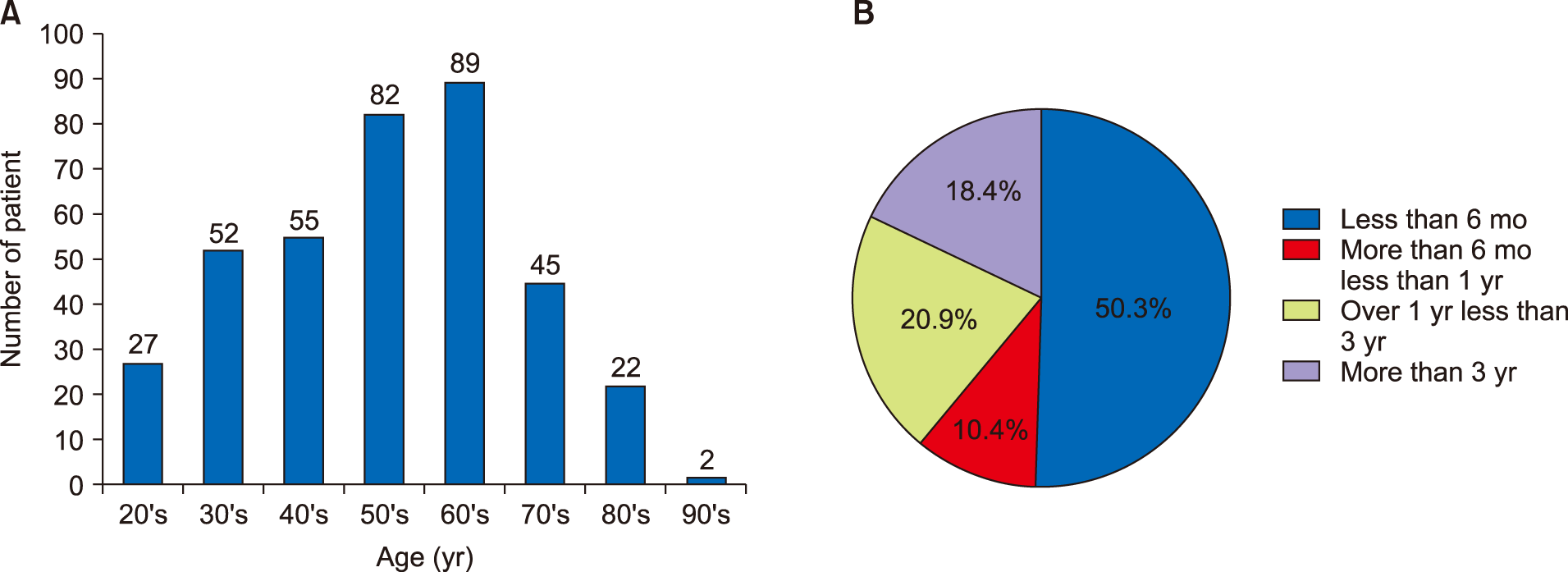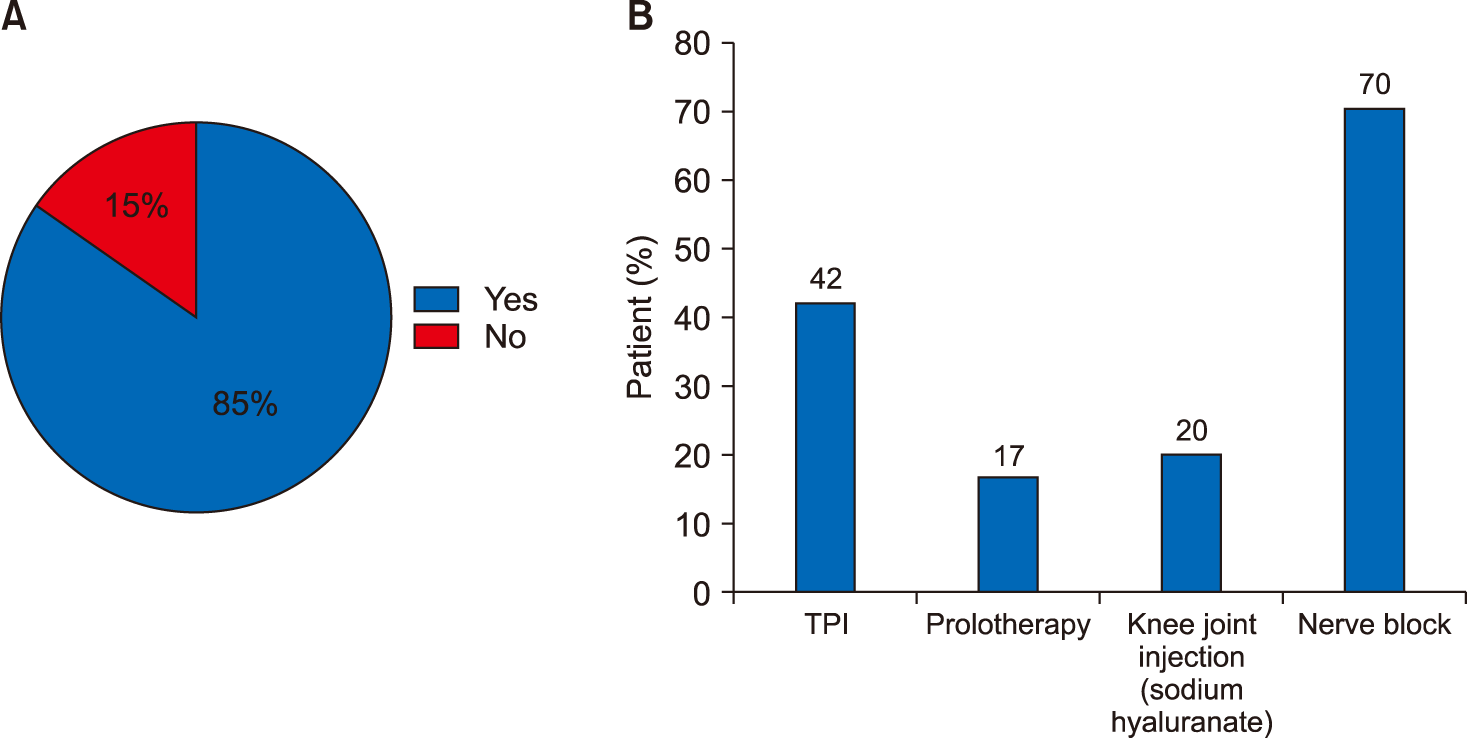INTRODUCTION
In pain clinics, injection therapy is used to inject drugs, including steroids, around joints or injured nerves to treat pain. Types include intra-articular injection, facet joint injection, tendon sheath injection, epidural injection and bursa injection. When some patients were recommended injections for treatment, they often asked whether the injection was a ‘ppyeojusa’ or whether it would harm their body. Ppyeojusa is what Koreans call steroid injection. Because some patients have a negative perception of ppyeojusa, in other words, steroid injection, they don’t want to use steroids in treatments for pain.
However, steroids are commonly used as a therapeutic agent in various fields, such as for skin diseases, skin depigmentation and atopy [
1]; rheumatic conditions [
2]; allergies; and respiratory diseases such as asthma [
3] because of their anti-inflammatory and anti-proliferative effects. Due to the broad indications of steroids, they have been prescribed frequently and without strict criteria, resulting in various side effects, such as skin discoloration, Cushing syndrome, osteoporosis, and immunosuppression, especially with long-term use [
4]. Steroids inhibit the function of inflammatory mediators, peripheral neural excitations, and neuronal sensitization. These mechanisms make steroids effective for patients with nerve compression, such as pain caused by disc herniation, or spinal stenosis. In addition, the neuroprotection effect of steroids can stabilize neurons, minimizing spontaneous discharge from unnecessary stimuli, and thus, provide analgesic effects in pain patients who are expected to have local nerve edema [
5–
7].
Despite the fact that steroids are used as treatment for so many conditions, many Korean patients have a negative perception of steroid drugs and/or injections, because of the side effects mentioned above. Some patients have elected to have non-steroidal injections instead; even though steroid injections would improve their pain or symptoms [
8]. This survey aimed to investigate patients’ perception of ppyeojusa, and whether their knowledge of steroid injections is accurate or not.
Go to :

MATERIASLS AND METHODS
Ethical approval for this study was waived by the Institutional Review Board of the Konkuk University Hospital (IRB file no. 2019-04-027). This was a cross-sectional study of patients who visited pain clinics. The survey was conducted by the Publicity Committee of the Korean Pain Society. Between August 1, 2017 and September 10, 2017, a questionnaire was completed by patients who visited a pain clinic at one of the nine university hospitals in Korea. Adults over 20 years of age participated. Patients attending for the first time and those attending follow-up appointments were both surveyed. Participants competed the questionnaire anonymously in the outpatient pain clinic. Patients who did not want to complete the questionnaire were excluded.
The questionnaire consisted of 13 questions (Appendix). Participants responded to questions relating to gender, age, attendance at the pain clinic, e.g., duration, experience of injection therapies, and the types of injections they have received at the pain clinic. For the types of injections, patients could select multiple options. The questionnaire also included items relating to ppyeojusa, e.g., the source of patient’s knowledge relating to ppyeojusa, patients’ perceptions, and the active constituent. For the source of their information, patients could also select multiple options. The questionnaire also asked if patients were aware of the use of steroids in many diseases; whether anesthesiologists are the specialists who provide injections for pain management; and whether they would consent to having a steroid injection if the pain specialist recommended it for treatment.
Go to :

DISCUSSION
According to the results of this survey, 74% of patients had heard of ppyeojusa. However, only 42% of patients knew that a ppyeojusa was a steroid injection. This indicates that although many patients have heard of ppyeojusa, most did not have accurate knowledge of what they are. Fifty-eight percent of patients did not know that ppyeojusa are steroid injections.
Steroid injection can be very effective in some patients. However, only 39% of patients knew that steroid injections are safe and without side effects if properly spaced. Twenty-one percent believed that steroid injections are injected into bone, and 15% thought steroid injections were terrible injections that dissolve bone. These patients did not know what ppyeojusa was, but believed it was bad for their health. Sometimes, patients declined their physicians’ recommendation of steroid injections even if the steroid injections could have improved their disease or symptoms. Patients’ negative thoughts may be related to the refusal of steroid injections.
Half of the patients did not know that steroids are useful for pain treatment, asthma, atopy, dermatitis, rheumatism, allergies and cancers. Indeed, excessive use of steroids is related to adverse side effects and should be avoided. However, the proper use of steroid is necessary for the improvement of some diseases and in treatment of pain. Eighty-eight percent of patients said that their physician always or usually explained about the drug, treatment, and complications, but 50% of patients were not aware that steroids are indicated for the treatment of many diseases. Therefore, physicians must make greater efforts in explaining the pros and cons relating to the use of steroids and steroid injections, to their patients. Sufficient explanation can also increase patients’ satisfaction [
9]. Despite 35% of patients perceiving steroid injections negatively, 89% would consent to having steroid injections if recommended by their pain physicians. This finding suggests that most patients trust their pain physicians and respect the physicians’ decisions.
To eliminate the fear and anxiety related to steroids among patients visiting the pain clinic, the physicians need to sufficiently explain the need for steroid therapy, treatment effects, and possible side effects. In addition, it is necessary that doctors or medical societies provide accurate knowledge about steroid injection through various means, such as hospital publications, YouTube, or mass media. Physicians should refer to the treatment guidelines when selecting therapies and treat patients with steroids as indicated to minimize the side effects of steroids and educate their patients to alleviate misconceptions. Physicians also can limit the use of total steroid dosage in same patients and reuse it after sufficient intervals.
As the population ages, the number of patients suffering chronic pain is increasing. As such, many patients visit a pain clinic, and the use of injection therapy is also increasing [
10]. Sometimes physicians use steroid injections, also known as ppyeojusa among Korean, for pain management, as well as for other conditions.
Corticosteroids are variants of cortisone, a derivative of cortisol. They have anti-inflammatory properties, reduce vascular permeability, and inhibit the production of inflammatory mediators, such as prostaglandins and leukotrienes, and inhibits c-fiber excitability. They are clinically very effective in reducing joint inflammation, erythema, edema, and acute pain, as well as increasing joint motility. The most commonly used corticosteroids are triamcinolone acetonide, methylprednisolone acetate, betamethasone acetate and disodium phosphate, as well as dexamethasone [
11]. Such steroids are used for various conditions, such as asthma [
3], atopy, dermatitis [
12], rheumatism [
2], allergies and cancers [
13], as well as pain. Since the indications and effects of steroids are very broad, steroids may be misused. For example, steroids may be prescribed in the early stages of treatment without strict criteria based on pharmacological actions. When used inappropriately, steroids may lead to many side effects. Patients who have experienced the side effects of steroids directly or indirectly, often have a reluctance or fear towards this medication [
14].
Kim et al. [
15] found that patients worried about steroid treatment were not limited to patients in pain clinics. This comparative study investigated patients’ perception of topical and oral steroids in dermatology in Korea. The findings from their questionnaire indicated that patients who had previously used topical steroids (46.7%), or oral steroids (53.8%) had “little anxiety”. Conversely, “overwhelming anxiety” was expressed by patients with prior experience of topical steroid therapy (4%), and oral steroids (11.5%). More than half of the patients who had used steroids, had anxiety about using the drug. This may be because information about the side effects of steroids came from the internet (67.5%), media (47.5%), and peripherally (38.3%). The study pointed out that steroid phobia has become over-exaggerated due to inaccurate information [
15].
Based on data accumulated by experts from each specialty over several years of clinical studies, guidelines for steroid therapy have been developed and are used safely by many physicians. Yet, patients are afraid of steroid treatments because more than half obtain treatment information through unprofessional routes. As demonstrated in the results of this study, 35% of the subjects obtained treatment information from mass media, such as newspapers, news, internet, and 47% from friends or relatives. Only about 18% of patients obtained information from an anesthesiologist, and 13% from other physicians. In this survey, many patients have heard of ppyeojusa but some patients did not know what ppyeojusa are, or the effects of steroids on several diseases. Physicians have to inform their patients about steroid treatment and its proper use.
The guidelines for the use of steroids in epidural block published by the Korean Pain Society in 2014 may be consulted for the treatment of pain [
16]. The guidelines include epidural steroid injections, dosages, intervals, guidelines for diabetic patients, and side effects associated with epidural steroid injections. In addition, the basis for steroid injections in spinal diseases, effects, and indications are listed.
To summarize the key points of these guidelines, epidural steroid injections should be given to patients who have indications, such as herniated discs, radiculitis, radiculopathy, spinal stenosis, post-surgery pain syndrome, and spondylosis; who do not have any infection at the procedure site, or blood clotting disorder, or any allergies to medication. If possible, an imaging device and contrast agent should be used to check the injection into the blood vessels and to the target point; and injecting the drug after fluoroscopic confirmation of epidural spreading. To be safe, observe vital signs and signs of neurological abnormalities for at least 30 minutes after the procedure before discharge.
In Korea, steroid that can be used in the epidural space is non-particulate dexamethasone. It is important to note whether a precipitation is formed or not, when mixed with other medications. Importantly, the interval and total number of epidural injections must be considered, but they are still controversial. There is little evidence to support that a repeated injection actually helps or alleviates pain. Nevertheless, in patients who were diagnosed with cervical disc herniation or spinal stenosis, the follow-up injection, 2 to 3 weeks after the first injection, was clinically more effective than an intermittent interval [
17]. It is clearly known that methylprednisolone, which can cause adrenocorticotropic hormonal depression, persists in the epidural space for more than 2 weeks. As such, it has been recommended that pain physicians consider a minimum interval of 2 weeks between injections [
7]. However, evidence supporting this interval is still not clear [
7].
The most common side effects of epidural steroid injections are pain, nausea, vomiting, and vagal syncope. Although rare, severe adverse events, such as epidural abscess, cerebrospinal fluid leakage, paraplegia, nerve, and damage, spinal cord infection may also occur. Therefore, patients must be provided with sufficient explanation to make an informed consent before the procedure [
16].
In conclusion, 74% of patients have heard of ppyeojusa. However, most of them did not know what the active constituent is, or the therapeutic use of steroids for many diseases. Only 31% of patients obtained information about steroids from medical physicians. Many patients have inaccurate knowledge about ppyeojusa or steroid injections. Therefore, doctors and the medical community must provide accurate knowledge of steroid injections through a variety of means. Although 35% of patients perceived steroid injections negatively, 89% of patients would consent to being treated with steroid injections if prescribed by their pain physicians. To maintain these trust relationship with the patients, physicians should explain sufficiently about the injection or treatment for pain.
Go to :






 PDF
PDF Citation
Citation Print
Print






 XML Download
XML Download